Application of Double Piping Theory to Parallel-Arrayed Low-Pressure Membrane Module Header Pipe and Experimental Verification of Flow Distribution Evenness
Abstract
1. Introduction
2. Research Methods
2.1. Membrane Filtration Process for Drinking Water Treatment
2.2. Methodology of CFD Simulations
2.3. Flow Distribution Measurement Using Ultrasonic Flowmeter
3. Results and Discussion
3.1. Results of CFD Simulations
3.2. Verification Experiment Results
4. Conclusions
- For the parallel-arrayed low-pressure membrane module inflow manifold header piping, the outflow increased toward the end of the header pipe instead of near the inlet. The outflow rate from the first branch pipe in the inlet and that from the branch pipe located at the end of the header pipe differed by three times or more. The increase in the outflow rate toward the end of the membrane module header pipe compared with that at the inlet was attributable to the increase in the differential pressure between each membrane module toward the end of the header pipe.
- By applying the double-pipe theory to the existing header pipe (with an open-end inner pipe and a closed-end inner pipe), the evenness in the flow distribution improved. The CFD simulation and experimental results showed that evenness of the flow distributed improved by approximately 70% and 50%, respectively.
- When the double-pipe theory was applied to the inlet header pipe in the parallel-arrayed low-pressure membrane module, the evenness of the flow distribution improved. In future studies, the position of the reducer and the optimal diameter of the inner pipe orifices should be determined.
Author Contributions
Funding
Institutional Review Board Statement
Informed Consent Statement
Data Availability Statement
Conflicts of Interest
References
- Park, N.S.; Yoon, S.; Jeong, W.; Jeong, Y.W. A Study on the Evaluation of Flow Distribution Evenness in Parallel-Arrayed-Type Low-Pressure Membrane Module Piping. Membranes 2021, 11, 751. [Google Scholar] [CrossRef] [PubMed]
- Kim, C.; Yoon, S.; Kim, S.; Kim, J.; Park, N. A Study on the Appropriateness Evaluation of Membrane Module Piping Design Using CFD Simulation Technique. J. Korean Soc. Environ. Eng. 2018, 40, 103–110. [Google Scholar] [CrossRef]
- Li, Y.L.; Tung, K.L. CFD Simulation of Fluid Flow Through Spacer-Filled Membrane Module: Selecting Suitable Cell Types for Periodic Boundary Conditions. Desalination 2008, 233, 351–358. [Google Scholar] [CrossRef]
- Ko, B.; Na, D.; Kang, K.; Lee, C. Fouling Mitigation for Pressurized Membrane of Side-stream MBR Process at Abnormal Operation Condition. J. Korean Soc. Environ. Eng. 2016, 38, 323–328. [Google Scholar] [CrossRef][Green Version]
- Hoinkis, J.; Deowan, S.A.; Panten, V.; Figoli, A.; Huang, R.R.; Drioli, E. Membrane Bioreactor (MBR) Technology—A Promising Approach for Industrial Water Reuse. Procedia Eng. 2012, 33, 234–241. [Google Scholar] [CrossRef]
- Ahn, Y.; Kang, S.; Bae, B.; Lee, C.; Lee, W. Direct Measurement of Cake Fouling Potentials by Powdered Activated Carbon during Microfiltration of Surface Water. Desalin. Water Treat. 2016, 57, 7449–7455. [Google Scholar] [CrossRef]
- Kim, S.H.; Moon, S.Y.; Yoon, C.H.; Yim, S.K.; Cho, J.W. Role of Coagulation in Membrane Filtration of Wastewater for Reuse. Desalination 2005, 173, 301–307. [Google Scholar] [CrossRef]
- Shen, P.I. The Effect of Friction on Flow Distribution in Dividing and Combining Flow Manifolds. J. Fluids Eng. Trans. ASME 1992, 114, 121–123. [Google Scholar] [CrossRef]
- Choi, S.H.; Shin, S.; Cho, Y.I. The Effect of Area Ratio on the Flow Distribution in Liquid Cooling Module Manifolds for Electronic Packaging. Int. Commun. Heat Mass Transf. 1993, 20, 221–234. [Google Scholar] [CrossRef]
- Datta, A.B.; Majumdar, A.K. Flow Distribution in Parallel and Reverse Flow Manifolds. Int. J. Heat Fluid Flow. 1980, 2, 253–262. [Google Scholar] [CrossRef]
- Eguchi, A.; Kuragasaki, M.; Sueoka, Y. Performance Improvement on ACDEFLO Headbox of Paper Machine, Mitsubishi Heavy Ind. Tech. Rev. 1988, 25, 191–196. [Google Scholar]
- Hong, J.C.; Riggs, J.B. Flow Distribution in Tapered, Rectangular Cross Section Manifolds. J. Chin. Inst. Chem. Eng. 1987, 18, 193–202. [Google Scholar]
- Muhana, A.; Novog, D.R. Validation of Fluent for Prediction of Flow Distribution and Pressure Gradients in a Multi-branch Header under Low Flow Conditions. In Proceedings of the 16th International Conference on Nuclear Engineering (ICONE16), Orlando, FL, USA, 11–15 May 2008. [Google Scholar]
- Chang, P.A.C.; St-Pierre, J.; Stumper, J.; Wetton, B. Flow Distribution in Proton Exchange Membrane Fuel Cell Stacks. J. Power Sources 2006, 162, 340–355. [Google Scholar] [CrossRef]
- Kim, J.; Kim, H.; Lee, H.; Hwang, S. A CFD Analysis of Gas Flow through an Ultrasonic Meter. In Proceedings of the KSME Conference, Busan, Korea, 23–25 April 2003; The Korean Society of Mechanical Engineers: Seoul, Korea, 2003; pp. 998–1003. [Google Scholar]
- Ding, W. Application of CFD in Membrane Technique. Ph.D. Thesis, Universität Duisburg-Essen, Duisburg, Germany, 2012. [Google Scholar]
- Oh, J.I.; Choi, J.; Lim, J.; Kim, D.; Park, N. A Study on Hydraulic Modifications of Low-Pressure Membrane Inlet Structure with CFD and PIV Techniques. J. Korean Soc. Environ. Eng. 2015, 37, 607–618. [Google Scholar] [CrossRef][Green Version]
- Park, J.; Yoon, S.; Kim, S.; Park, N. Physical modifications for improving inlet flow distribution evenness in multiple parallel-arrayed membrane modules. Desalination Water Treat. 2018, 119, 1–8. [Google Scholar] [CrossRef]
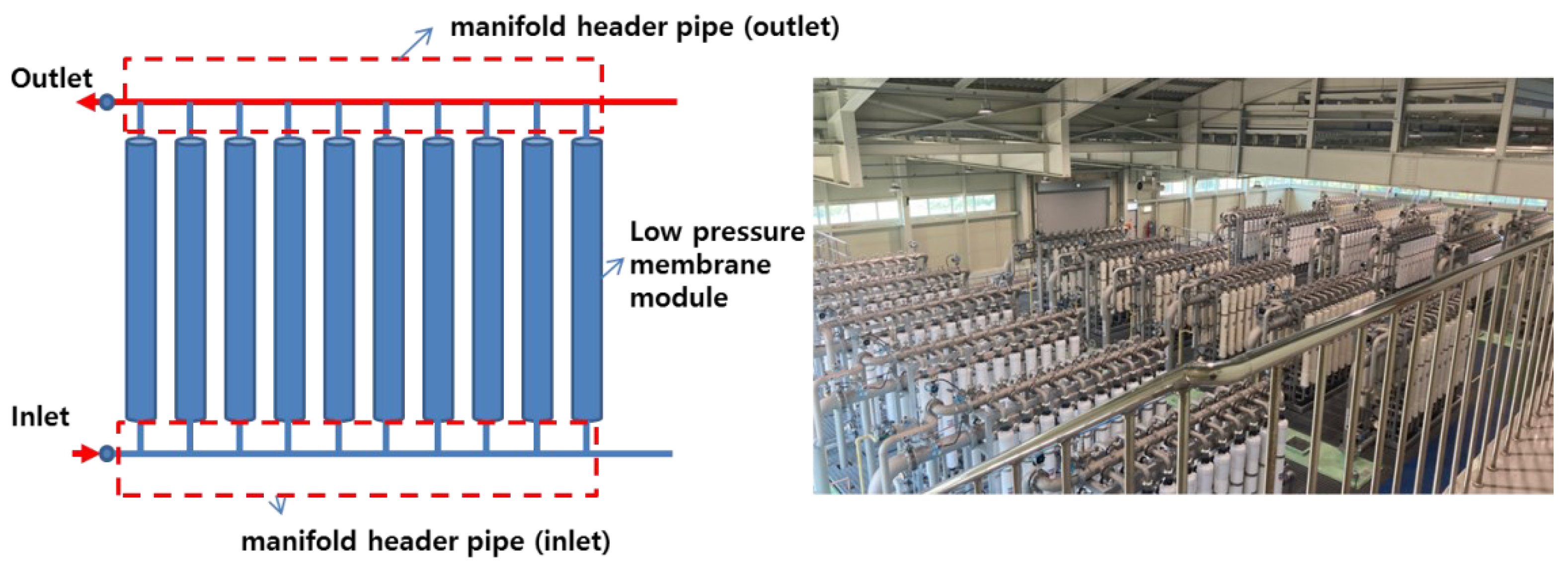

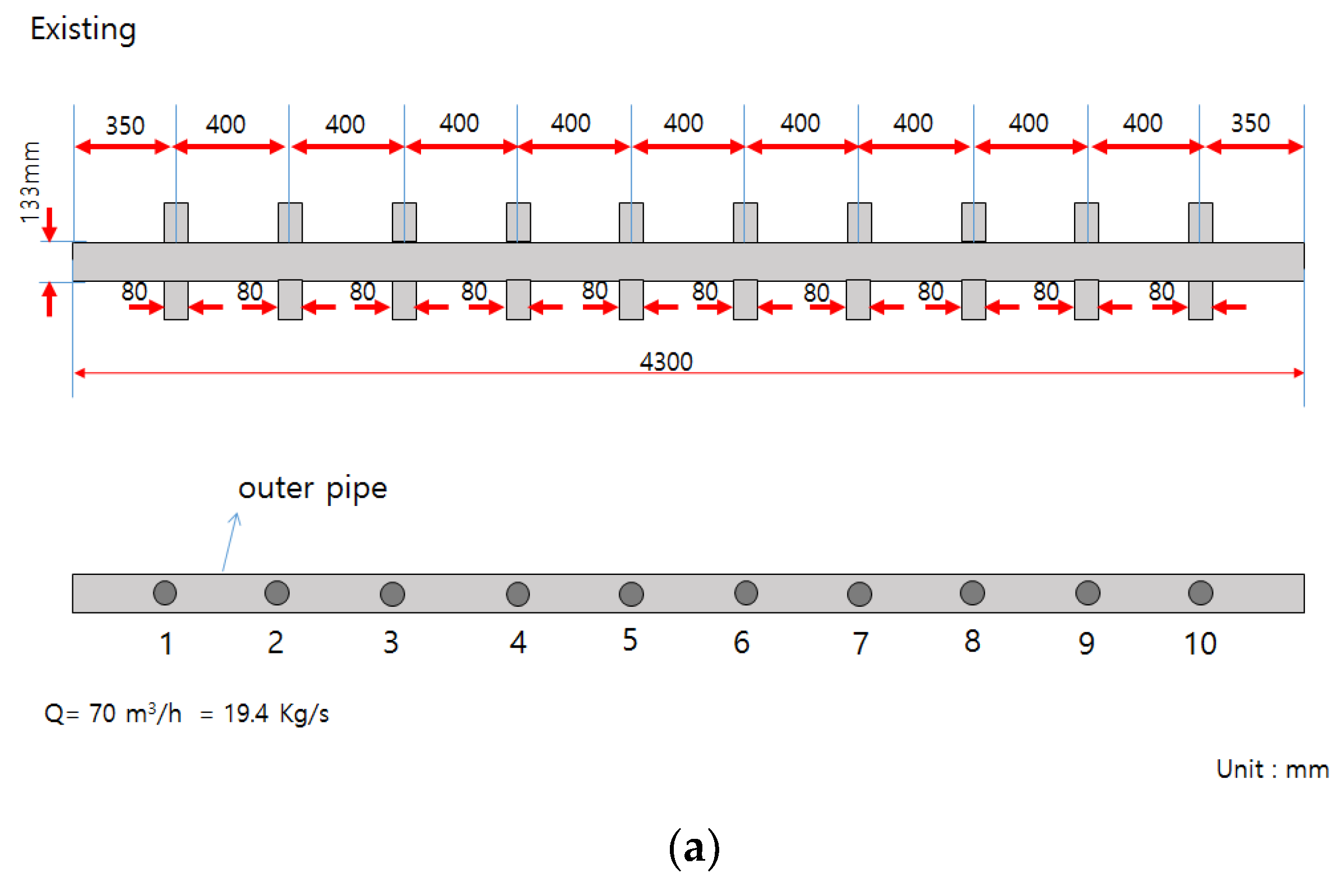
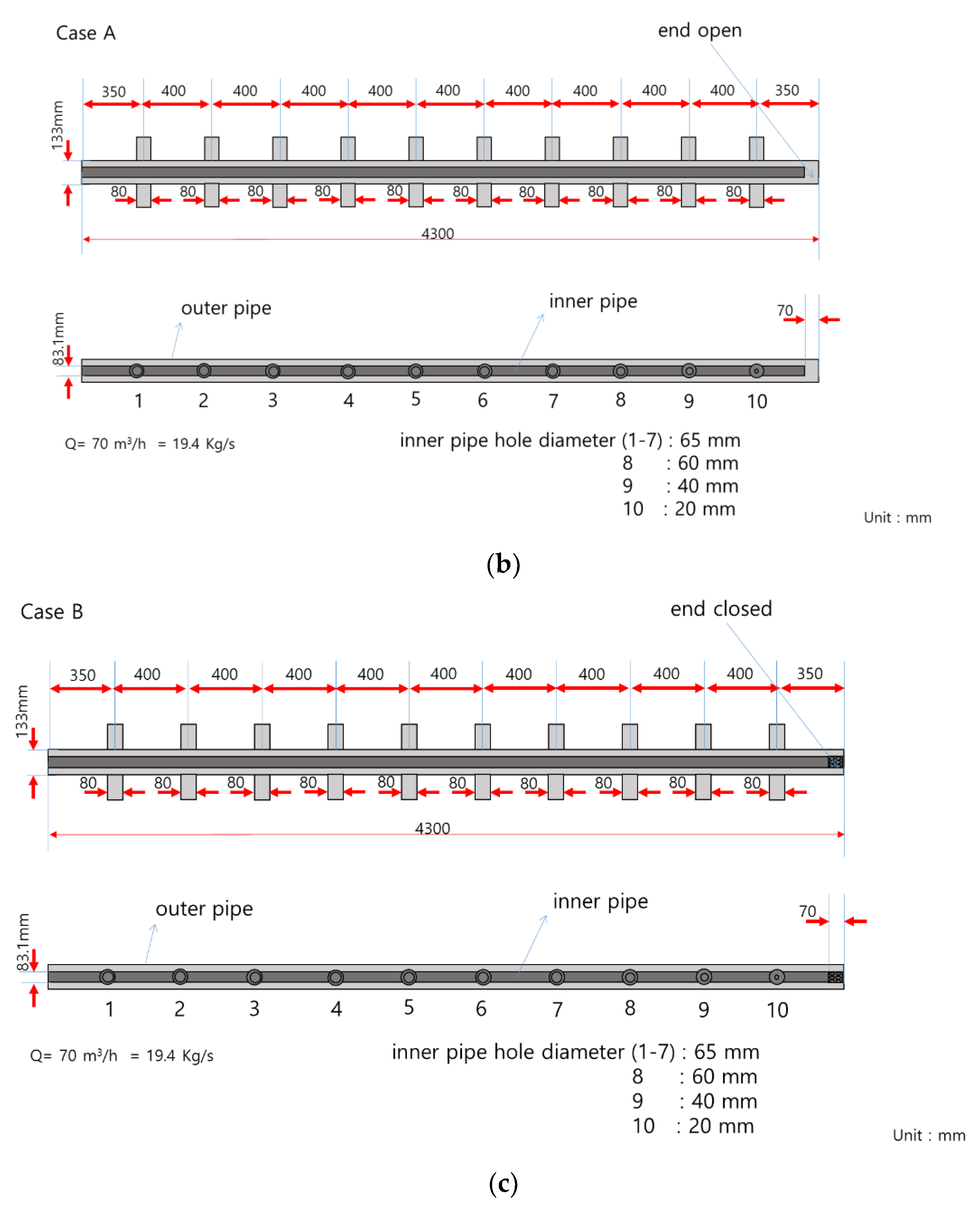
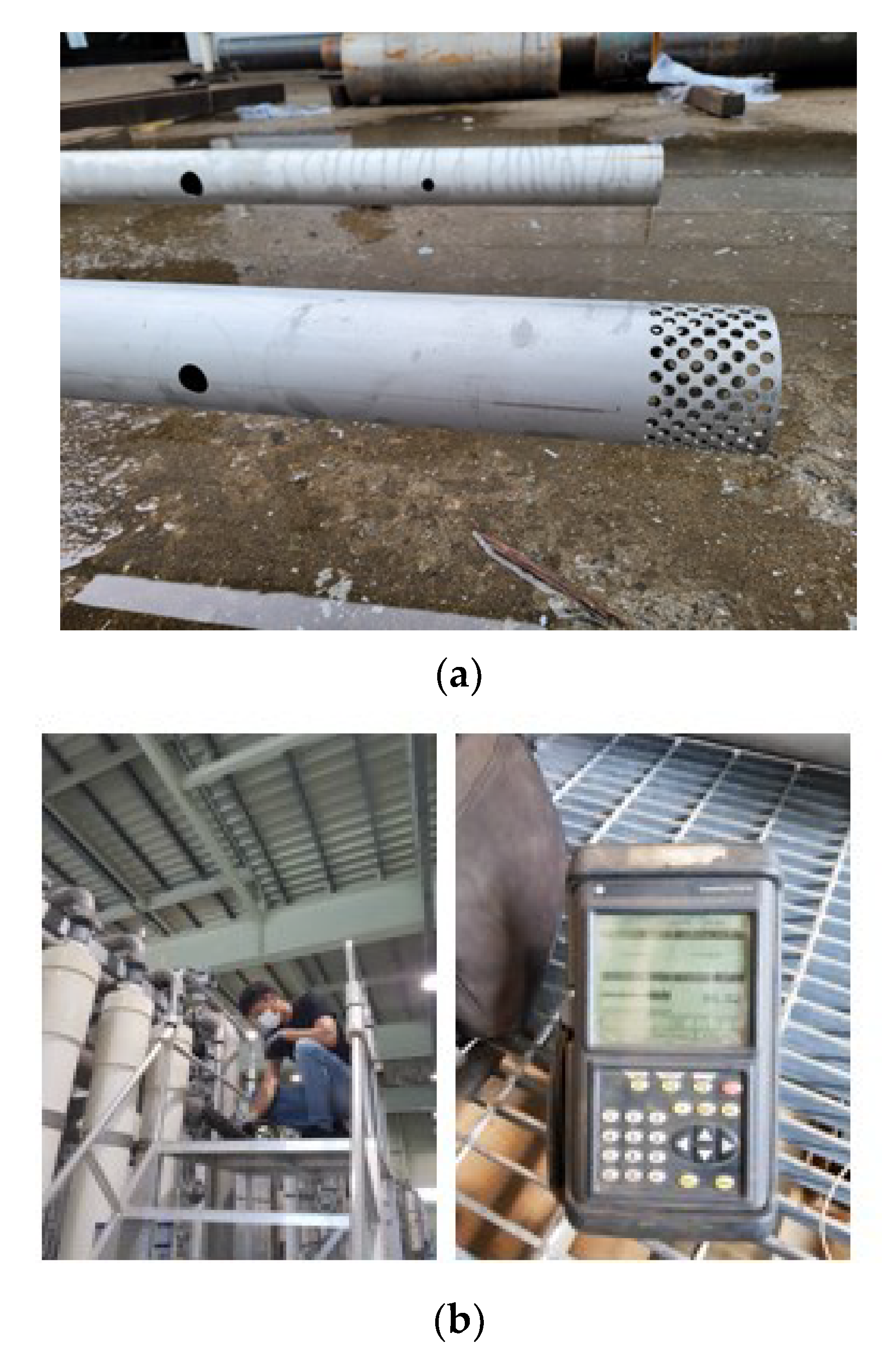
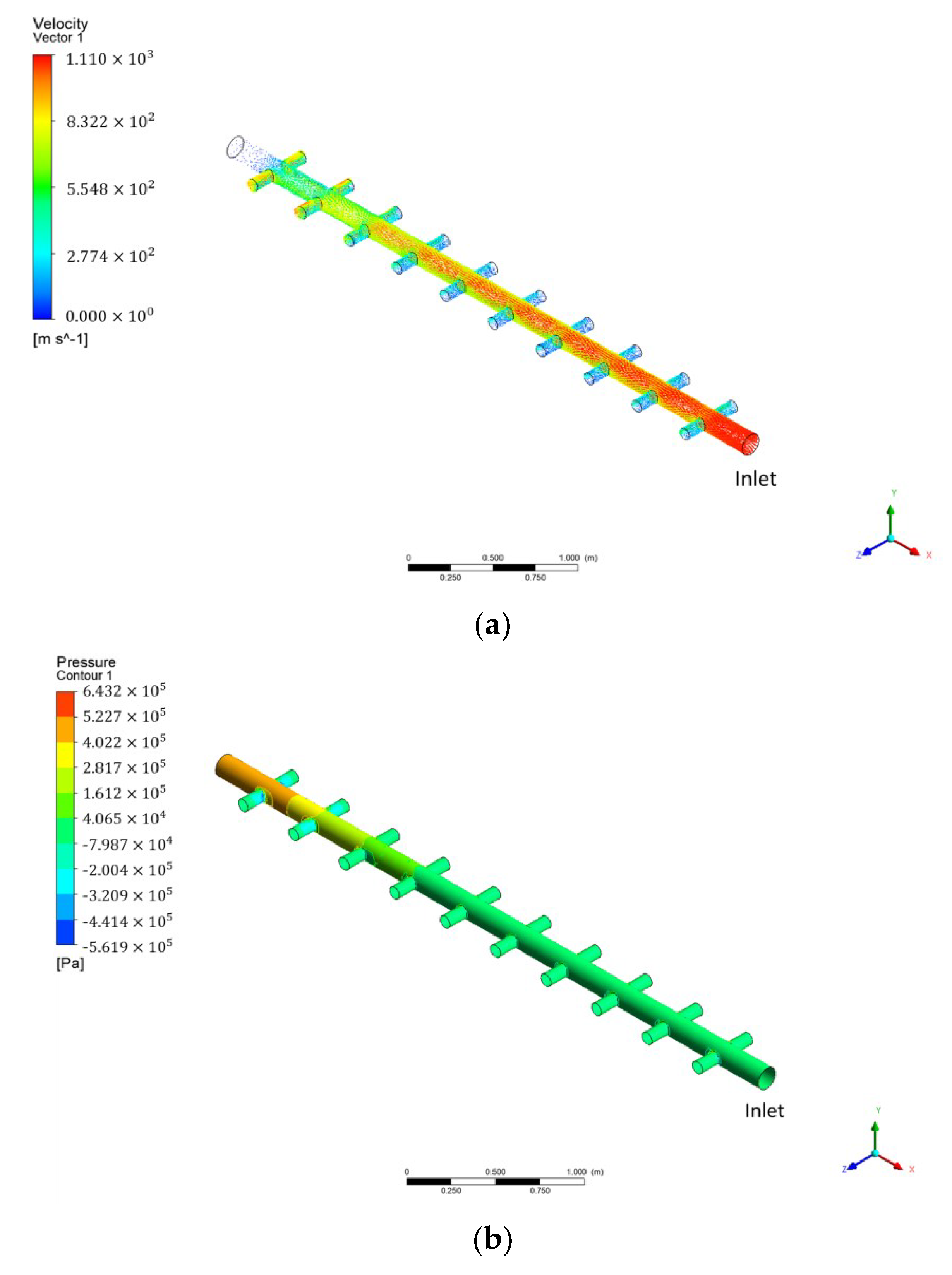

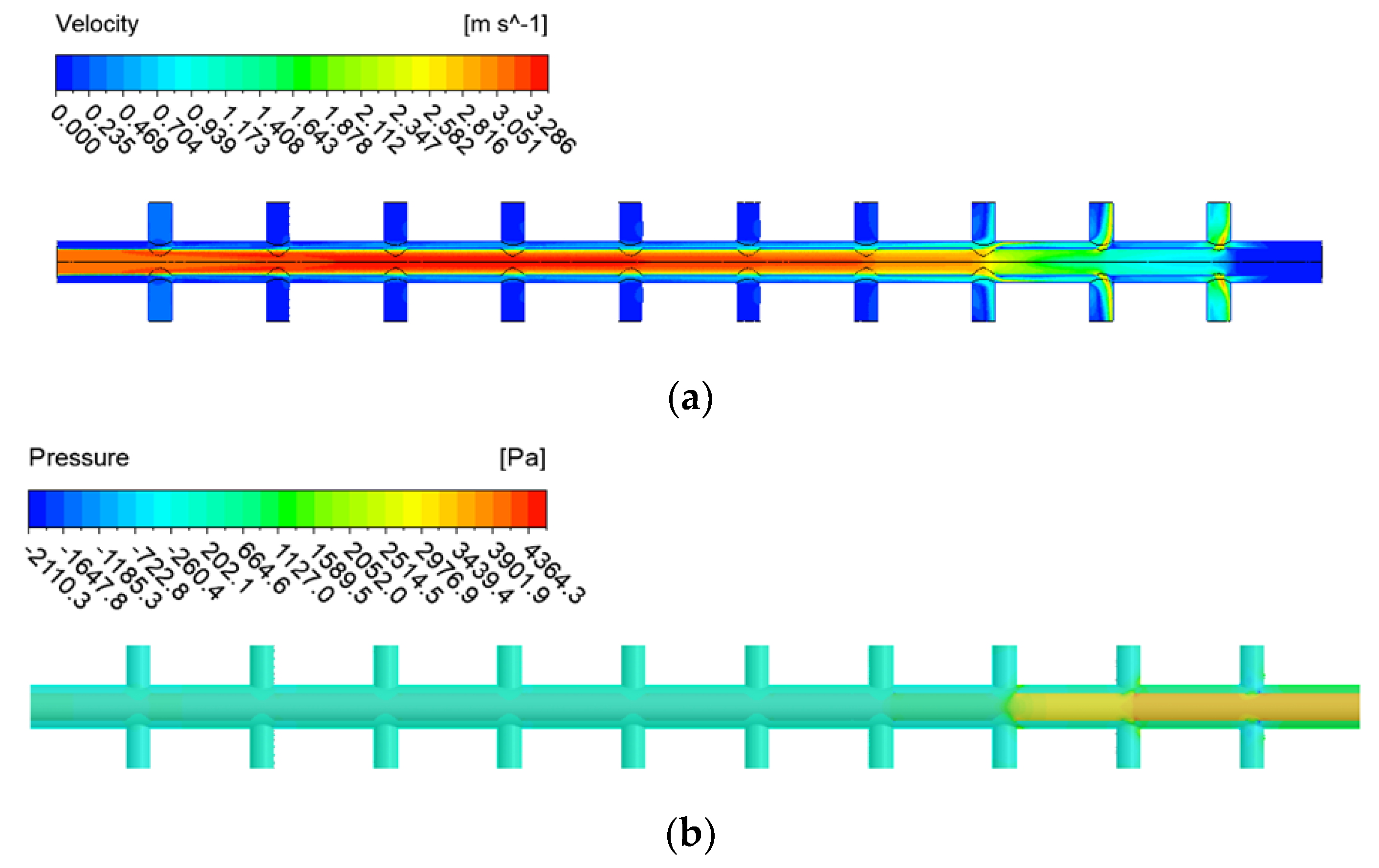
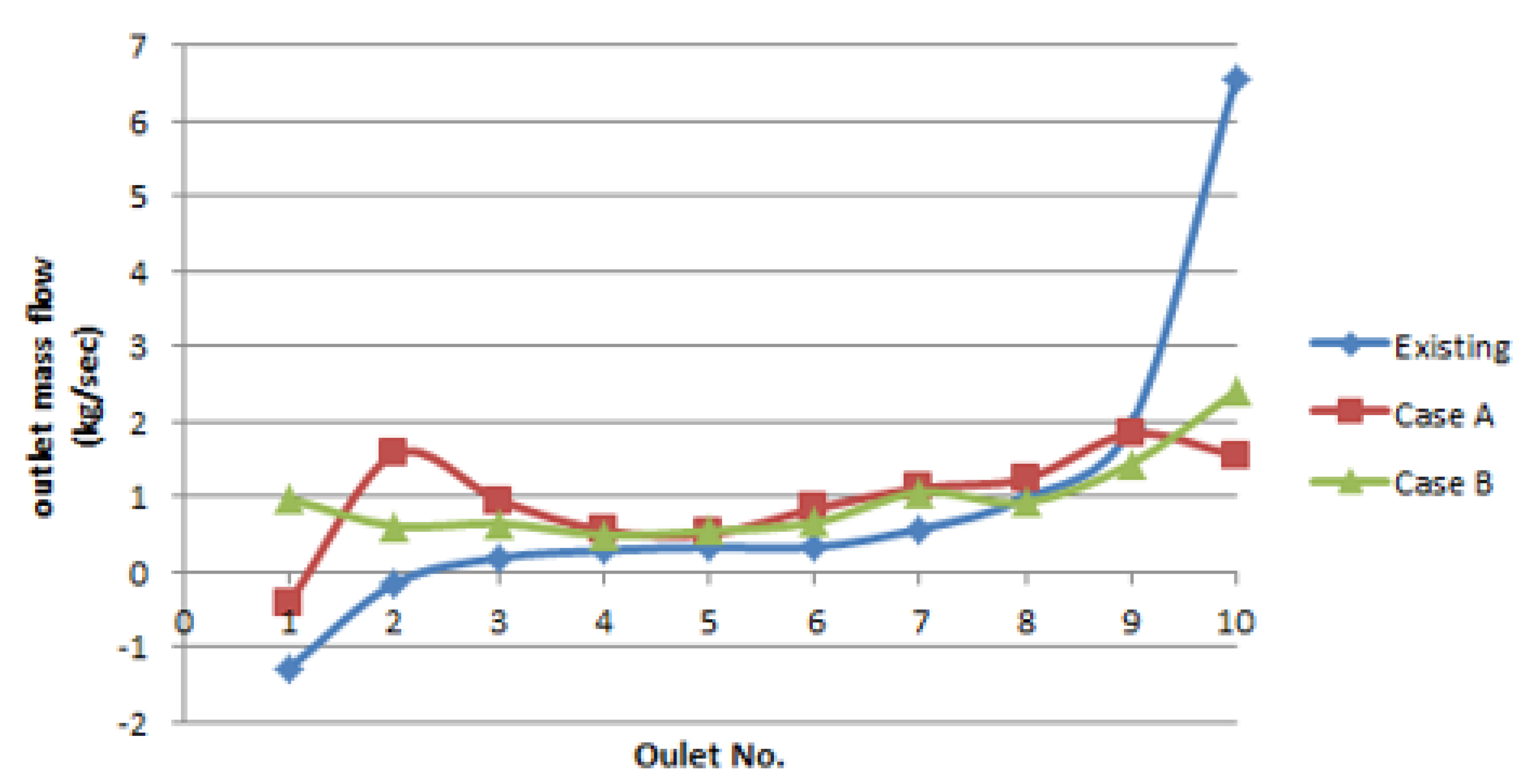

| Membrane Manufacturer | Toray, HFS-2020 |
|---|---|
| Membrane type | Microfiltration |
| Membrane module shape | External pressure-type hollow-fiber membrane (casing) |
| Hollow fiber | Inner D 0.9 mm/external D 1.4 mm |
| Pore size | 0.05 µm |
| Membrane material | PVDF |
| Flux | (Ordinary) 1.0 m3/m2/day |
| (Max.) 1.33 m3/m2/day | |
| Module size | D 216 mm × L 2160 mm |
| Membrane area | 72 m2/module |
| Allowable pressure | 300 kPa |
| Allowable pH | 1–10 during filtration, 1–12 during chemical cleaning |
| Flowmeter | PT878 | Transducer Type | Clamp-On |
|---|---|---|---|
| Flow type | All acoustically conductive fluids | Applications | Liquid |
| Pipe size | 12.7–7.6 m | Compatible meters | PT878 |
| Pipe wall thickness | Maximum of 76.2 mm | Frequency | 1 MHz |
| Pipe material | All metals and most plastics | Process temp. | −20 °C to 210 °C |
| Repeatability | ±0.1% to 0.3% of reading | Ambient temp | −20 °C to 40 °C |
| Range | −12.2 to 12.2 m/s | Materials of construction | Metals and plastics |
| Range ability | 400:1 | ||
| Measurement parameters | Volumetric flow, totalized flow, and flow velocity |
| Outlet No. | Existing (m3/h) | Case A (m3/h) | Case B (m3/h) |
|---|---|---|---|
| 1 | 2.28 | 2.44 | 2.46 |
| 2 | 2.49 | 3.1 | 3.13 |
| 3 | 2.5 | 3.31 | 3.28 |
| 4 | 2.66 | 3.1 | 2.97 |
| 5 | 2.59 | 2.91 | 3.2 |
| 6 | 3.55 | 3.1 | 3.0 |
| 7 | 3.22 | 2.57 | 2.49 |
| 8 | 3.21 | 2.85 | 2.39 |
| 9 | 3.34 | 3.31 | 3.0 |
| 10 | 3.9 | 2.98 | 3.2 |
| Standard deviation | 0.540 | 0.286 | 0.337 |
Publisher’s Note: MDPI stays neutral with regard to jurisdictional claims in published maps and institutional affiliations. |
© 2022 by the authors. Licensee MDPI, Basel, Switzerland. This article is an open access article distributed under the terms and conditions of the Creative Commons Attribution (CC BY) license (https://creativecommons.org/licenses/by/4.0/).
Share and Cite
Park, N.-S.; Yoon, S.; Jeong, W.; Jeong, Y.-W. Application of Double Piping Theory to Parallel-Arrayed Low-Pressure Membrane Module Header Pipe and Experimental Verification of Flow Distribution Evenness. Membranes 2022, 12, 720. https://doi.org/10.3390/membranes12070720
Park N-S, Yoon S, Jeong W, Jeong Y-W. Application of Double Piping Theory to Parallel-Arrayed Low-Pressure Membrane Module Header Pipe and Experimental Verification of Flow Distribution Evenness. Membranes. 2022; 12(7):720. https://doi.org/10.3390/membranes12070720
Chicago/Turabian StylePark, No-Suk, Sukmin Yoon, Woochang Jeong, and Yong-Wook Jeong. 2022. "Application of Double Piping Theory to Parallel-Arrayed Low-Pressure Membrane Module Header Pipe and Experimental Verification of Flow Distribution Evenness" Membranes 12, no. 7: 720. https://doi.org/10.3390/membranes12070720
APA StylePark, N.-S., Yoon, S., Jeong, W., & Jeong, Y.-W. (2022). Application of Double Piping Theory to Parallel-Arrayed Low-Pressure Membrane Module Header Pipe and Experimental Verification of Flow Distribution Evenness. Membranes, 12(7), 720. https://doi.org/10.3390/membranes12070720






